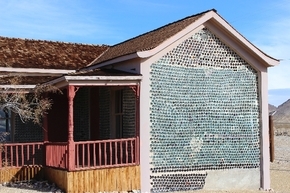Town of Rhyolite rife with rock, gold, history


Just a two-hour drive north of Las Vegas lies the ghost town of Rhyolite. Accessible even to low-slung street vehicles, it’s one of the easiest to visit of Nevada ghost towns, yet one of the most photogenic. And it is only a few minutes west of Beatty, not far off the main route to Reno and beside one of the main routes to Death Valley, so a short visit there is easily combined with some other trip.
Rhyolite, named for a silica-rich volcanic rock found in the area, came into being after prospectors Shorty Harris and Ed Cross found a rich deposit of gold there. Harris particularly was the epitome of what he called himself: “A single-blanket, jackass prospector.” He found more than one rich claim but always sold them out to finance for his twin passions of further prospecting and drinking whiskey. He did the latter so liberally that he imagined a penguin following him around the blistering deserts.
After word spread about this find, people came to the area lickety-split. As most towns did in that time, Rhyolite started as a tent camp and quickly grew into a thriving town. Businesses were set up to support the population that some say reached 10,000 during the boom period between 1905 and 1910. There were three railroads, churches, an ice plant, a hospital, a school, swimming pools, saloons and brothels.
A good place to start any visit is at the Tom Kelly Bottle House, on the right as you first enter the town. There you can pick up an auto/walking tour sheet that includes a map of the town and the highlights that shouldn’t be missed.
Tom Kelly, the ultimate recycler, built his house in 1906 with about 50,000 used beer and liquor bottles held together by mud. He probably utilized the bottles because more conventional building materials were expensive in any boom town, but they had other advantages besides being presumably free. These bottles had good insulating qualities, let daylight enter and never required painting to keep their color. Although there are a few other bottle houses in Nevada, including ones in Tonopah and Goldfield, this is in the best condition of any. Locals preserved the original structure by rehabilitating and stabilizing it in 2005.
From the bottle house, head out on foot or in your vehicle up the main drag to see some of the other ruins. One of the most impressive is the three-story Cook Bank building on your left, which is now fenced. This building was built in 1908 and has a basement. The structure not only served as a bank but also housed the post office and a couple of businesses. The Cook Bank building had electric lights, steam heating and even marble floors.
Other not-to-be-missed sites include the Las Vegas and Tonopah Depot, erected in 1909; the jail, which was erected in 1907; and the Overbury Ruins. It is fun to walk the old side streets that appear to be entirely empty. On closer inspection, you will find the remains of small miner homes as well as lots of old rusty cans and other archaeological gems. Don’t forget that these piles of trash have historical value, so do not remove or disturb any artifact such as these.
Rhyolite didn’t fall by the wayside because the gold ran out but rather because the confidence did during the financial panic of 1907. It was then that depositors pulled their money out of banks, so there wasn’t any available for the loans that would have financed further development. Once the mines closed, people started heading out for a better future elsewhere. By 1910, only about 600 residents remained. In 1916, the power was turned off, the town was all but abandoned, and in 1920, the population is said to have been only 14 people.
On your way out of town, it is worth some time to stop at the Goldwell Outdoor Air Museum. The largest sculpture there is a 24-foot-high steel silhouette statue that probably is a tribute to Shorty Harris, accompanied, of course, by his indispensable prospecting pick and his imaginary penguin.
Deborah Wall is the author of “Great Hikes, A Cerca Country Guide” and “Base Camp Las Vegas: Hiking the Southwestern States,” published by Stephens Press. She can be reached at deborabus@aol.com.












